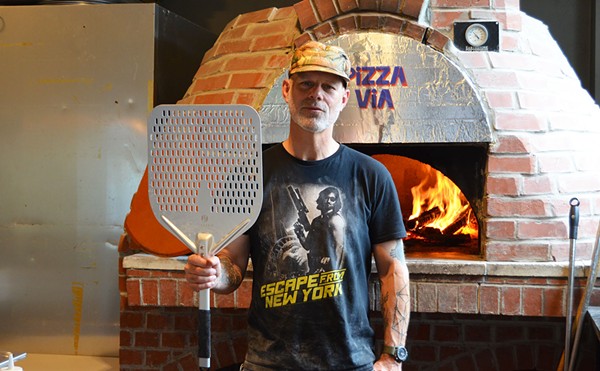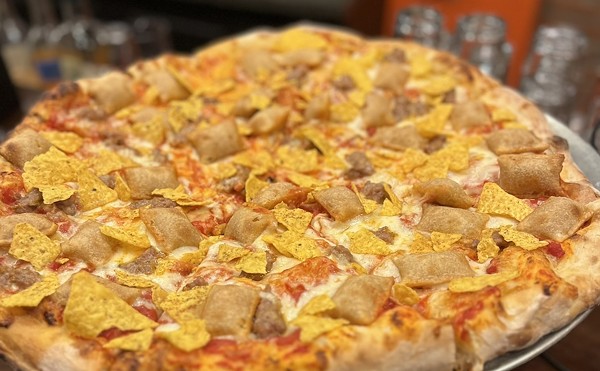I don't remember any stamping during my visits to three-month-old Wapango — maybe a few Saturday-evening walk-ins when they learned how long the wait would be — but swap "men and women" with "restaurant and diners," and the name fits.
Wapango — a "pan-Latin experience," as the sign and the menu and even the receipt says, with cuisine from Mexico and Central and South America — is a brilliantly executed dance. You can feel its rhythm as soon as you walk in the door. The buzz from the bar, where — on the weekend, at least — you'll have to wait. The sizzle from the open kitchen. The steady beat of servers bearing oversize plates of brightly colored dishes. It's one of those restaurants that doesn't seem designed or built, but rather transplanted whole from an alternate universe where the servers always wear black and know the thoughtful, affordable wine list by heart, where entrées arrive just after apps have been cleared, where even the sample items on the dessert tray look like they were made fresh just for your perusal.
Although Wapango is connected to the Westfield Chesterfield shopping mall, you enter from outside. You can't miss the place: The back-lit Wapango sign changes colors every half-minute or so, and along the sidewalk sit several large concrete spheres with jagged, glowing indentations. Of course, with the entrance to the Cheesecake Factory about 50 feet away, Wapango's exterior seems downright understated.
The interior, on the other hand, is breathtaking, a massive space with a soaring ceiling and at least one brilliant design element: a series of spokes like mutant marsh reeds, or a picket fence uprooted by an earthquake. The spokes are eye-catching, but they also separate what would be a cattle-call dining room into several distinct areas. And in spite of Wapango's size, if you sit in one of the cushy, high-backed booths, you'll feel like you're the only party in the place.
None of this is surprising, considering the restaurant savvy of Wapango's management team. John Gianoulis was formerly the regional director for the Casa Gallardo chain of Mexican restaurants, while front-of-house manager Todd Wyatt formerly worked at the popular Chesterfield spot Crazy Fish.
Executive chef Jason Sparks tries to match the excitement that Wapango's atmosphere generates. He succeeds in style, if not always in substance. His creations all look fantastic on the plate. I ate several excellent dishes — but I also had more than a few that, while satisfying, weren't nearly as complex or intriguing as their descriptions and presentations suggested.
Meals begin with "Cuban rolls," which, depending on your point of view, are either light dinner rolls or dense biscuits. These are served with two spreads, one an Argentinean chimichurri sauce, the other essentially refried black beans. I don't often mention the bread-and-butter course, but that chimichurri sauce was fantastic.
There's no one way to make a chimichurri sauce. At Wapango it's a blend of olive oil, parsley, garlic, serrano chiles (very few here; the sauce isn't too hot), salt, pepper and a dash of cumin. "Dash" is the key word. Few ingredients overpower as easily as cumin, but here it provides both depth and bite to a sauce that otherwise wouldn't be much different from pesto. The result is a light, mildly spicy sauce that brightens heavier fare: the dinner rolls, an order of spicy, battered "Yuca Fries" and, really, anything else you put it on.
A tuna ceviche was simply bright: excellent ahi tuna "cooked" in lime juice, then lightly dressed with coconut milk, a mix of red and yellow bell peppers, pickled onion and cilantro. Two other appetizers, "Coco Pollo Sticks" (basically coconut-flake-breaded chicken strips) and "Langostino Spring Rolls" (basically spring rolls), were memorable on account of the mango-habañero salsa that accompanied both.
In general, the best dishes at Wapango provide a balance of the savory and the sharp. The "Latino Tenderloin" is an eight-ounce tenderloin paired with "Ecuadorian langostino tails in a garlic mojo." Langostinos are small crustaceans with a flavor somewhat like lobster. (The fast-food chain Long John Silver's was sued earlier this year after it marketed langostino as "langostino lobster.") The buttery, succulent tails were a clever match with the tender, juicy and flavorful tenderloin: a lighter surf-and-turf. The garlic sauce, much like the chimichurri, brightened the dish, cutting through the richness.
Likewise, "Chicken Adobo," a half-chicken that's roasted on a spit, was notable for its "ceviche" of mashed avocado and corn. Part guacamole, part salsa, it and pico de gallo perked up the ample portion of smoky, crisp-skinned chicken. Crab-spinach enchiladas were understated but delicious: generous helpings of sweet crab meat and sautéed spinach wrapped in spinach crèpes and topped with a mild cream sauce.
These enchiladas show the subtlety of which Sparks is capable. Too often, though, his dishes strike a single, too-simple note. The trend begins with that black-bean sauce that comes with the bread-and-butter course. The sauce is hearty and satisfying, but not terribly interesting. In truth, I would've forgotten it entirely had it not also been served with several appetizers. In each case, the bean sauce not only failed to elevate the dish, it weighed it down — especially the arepas, corn cakes also topped with pork carnitas and "chile-orange mojo". Empanadas de queso, a mild (and lukewarm) mixture of queso fresco, cojita and Monterey Jack, were more salty than pungent; a light, spicy salsa would have provided a better contrast. Plantain strips were just plain boring, black-bean sauce or no.
Brazilian moqueca, a stew of shrimp, scallops, mussels, and calamari in a coconut-milk broth, sounded excellent on the menu. The scallops were plump, but the mussels were small, the calamari tough. The broth featured garlic, onion, tomato and bell pepper, but these could hardly make themselves heard above the rich, sweet coconut milk. I enjoyed my first few bites of "Tamarind Salmon" but found it cloyingly sweet thereafter. Aside from a bland quinoa pilaf, the dish had nothing to balance out the too-sweetness of the glaze; the "hint of habañero chile" the menu promised was just a rumor. A missed opportunity, really, because in theory the sweet-sour flavor of tamarind pulp would be a welcome presence on a plate such as this.
Of all the dishes I tried at Wapango, cochinita pibil was perhaps the most ambitious — and the most frustrating. This is a traditional Yucatán dish. Recipes generally call for pork marinated in sour orange juice, achiote paste (known for its distinctive reddish hue as much for its flavor) and various spices, then roasted inside banana leaves. At Wapango, it's a big to-do. The waiter opens the banana leaves at your table with a flourish. Steam pours out, and then you dig into...pork. It was tender but didn't have much flavor besides (undeniably good) roasted pork with a little salt and pepper. Only the pickled onions served on the side boosted the dish beyond ordinary.
The wine list is refreshingly different, composed almost exclusively of Latin American wines, including a large selection of Argentinean malbecs. And desserts are excellent: Chocolate fritters (think chocolate doughnut holes) would have been indulgent all by themselves but came with dulce de leche-flavor ice cream and caramel sauce.
Also quite good was the cuatro leches cake, which is layered with a strawberry paste and served with a mango sauce. This, obviously, is a riff on traditional tres leches cake. The four milks — whole, half-and-half, condensed and coconut — resulted in an incredibly moist (but not soggy) cake, and the fruit added exactly the right touch of natural sweetness. It was representative of Wapango at its best: audacious in presentation ("Tres leches aren't enough! There must be cuatro!"), subtle in flavor.
It's hard not to like a place with such unabashed swagger — especially in such a cookie-cutter suburban shopping mall. Wapango has rhythm to spare. The melody just needs to be louder.





